Signs and Symptoms of Emerald Ash Borer
Background
Mississippi landowners and communities may soon be threatened by a tree pest that is one of the most devastating invasive insects ever introduced to North America (Herms and McCullough 2014). The emerald ash borer (Agrilus planipennis) (EAB) has killed hundreds of millions of ash (Fraxinus spp.) trees since its introduction to southeast Michigan in the mid-1990s (Siegert et al. 2007). Efforts to contain the spread of EAB largely have been unsuccessful, as 35 states currently have confirmed infestations, including Louisiana, Arkansas, Tennessee and Alabama.
Although ash represents only a small fraction of all forest trees in Mississippi, the recent advance of EAB into the South is troubling. This is because ash lumber has a high economic value and, within the past 30 years, has been widely planted on alluvial soils throughout the state through federally funded conservation programs. In the Delta region of Mississippi, ash has historically comprised about 20 percent of the marketable timber species. In addition to its value as a commercial forest species, countless ash trees are planted in city and residential landscapes.
While we cannot predict if or when EAB will reach Mississippi, early detection is an important factor in reducing its potential financial impact. Consequently, learning to recognize the signs and symptoms of EAB is important for anyone interested in ash. This publication gives information that will help you identify EAB in the adult and larval stages, recognize signs and symptoms of an EAB-infested tree, and understand the life cycle of the EAB. Collectively, this information will help you identify EAB if it appears in ash trees in your forest or municipality.



EAB Identification
Adults
EAB adults are peg-shaped beetles, with a tapered, dull pointed rear and blunt head. They are about three-eighths to one-half inch long and a little less than one-eighth inch wide. The most distinctive characteristic of EAB is its metallic green color. It should be noted, however, that many insects have a similar metallic green appearance, and some EAB are colored in shades of red or blue. One distinguishing characteristic of EAB is its bright purple abdomen (beneath the wings), which is visible when the beetle is in flight. In the northern half of the state, adult EAB should emerge in March and be active through November. In the southern half of the state, adult EAB will likely be active throughout the year.
Larvae
EAB larvae are cream-colored and about 1½ inch long when fully grown. The key identifiable feature is their flattened, elongated bodies, which are composed of a series of segments shaped like stacked bells or cones. The larvae can be found beneath the bark where they feed on the cambium.
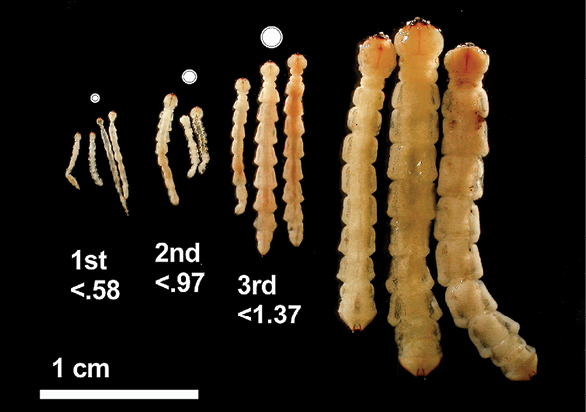
Signs and Symptoms
Woodpecker Damage
EAB larvae provide an excellent food source for woodpeckers. As a result, infested trees typically receive a high degree of damage to their outer bark from woodpeckers attempting to extract EAB larvae. Woodpecker damage is an important early detection sign, as it may precede any other visible sign or symptom. However, the presence of woodpecker damage does not necessarily indicate the presence of EAB larvae, as woodpeckers also feed on other wood-boring insects. If you see extensive woodpecker damage on your ash trees, you should look for galleries beneath the bark to confirm EAB’s presence.
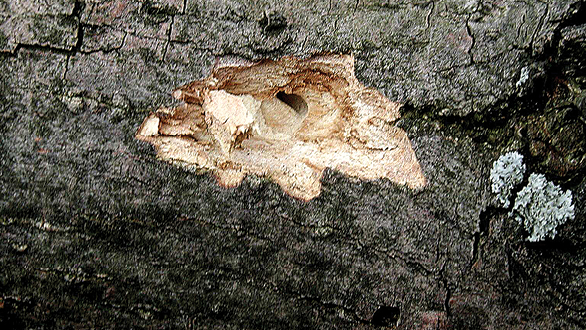
Galleries
Finding larval galleries in the cambium is another reliable sign of EAB attack. These winding, S-shaped galleries exist just beneath the bark and are created by the feeding larvae. It is the girdling effect of these galleries that damages the tree and eventually causes tree death. Of course, you will need to use a hand tool to remove the outer bark in order to see feeding galleries. We strongly encourage you to consult with a professional arborist or forester before removing any segment of the bark, unless the tree damage is not a concern.
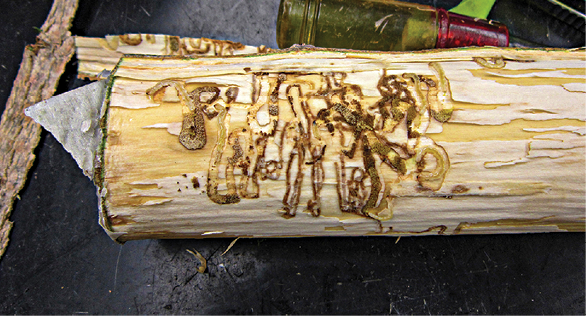
Exit Holes
Exit holes are a reliable sign of EAB infestation, but EAB exit holes are small and can be difficult to detect. While most boring insects leave exit holes, EAB’s are quite distinctive because they are D-shaped and very small (one-eighth inch). Two negatives to relying on exit holes are (1) the beetles have already inflicted damage to the tree and moved on, and (2) the earliest exit holes are formed high in the canopy where EAB attacks typically start. Nevertheless, periodic examination of ash trees for small, D-shaped exit holes is a useful practice for early EAB detection.
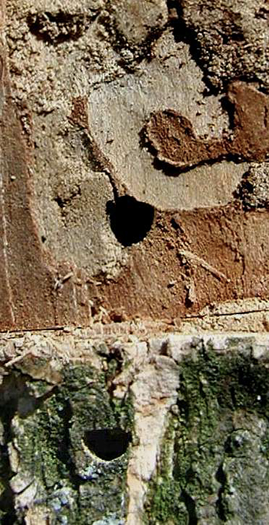
Crown Dieback
Crown dieback is the most visible symptom of EAB infestation. Unfortunately, dieback typically does not occur until 2–5 years after the tree was initially attacked. Dieback is from the tree’s diminishing ability to transport water and nutrients throughout its vascular system as a result of extensive larval feeding. Because there are many other types of injury or stress that can cause ash trees to experience crown dieback, you should also check for the presence of exit holes and galleries to confirm whether EAB is responsible.
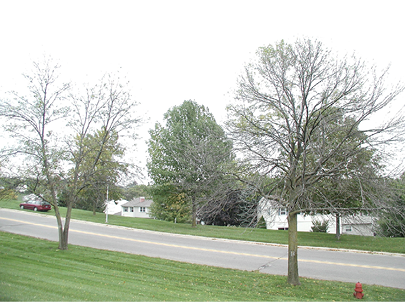
Basal Sprouting
Another highly visible symptom of EAB infestation is basal sprouting. In response to stress, trees sometimes grow new branches from the trunk of the tree. With EAB, this generally happens near the area where the tree was attacked. Much like crown dieback, basal sprouting takes time to develop as the tree becomes stressed. As a result, the tree has already suffered serious damage when sprouts begin to appear. It should be noted, however, that basal sprouting does not confirm EAB presence, as many factors can facilitate basal sprouting.
Life Cycle
EAB is relatively new to the South and climate/ecosystem differences may result in changes to the life cycle of the species, thus there is limited documentation of EAB behavior in the region. Consequently, the life cycle of EAB as it occurs in northern states is referenced. In northern climates, EAB completes one generation every 1–2 years. Eggs are laid between layers of outer bark and in crevices of the trunk/branches from mid-June into August. Depending on temperature, egg hatching occurs after roughly 2 weeks. Newly hatched larvae then tunnel through bark into the tree’s cambium (the living part of the tree) to feed. Galleries are created in the outer sapwood during this feeding. These galleries are S-shaped and are packed with frass (waste).
The majority of larvae mature during September and then pupate inside a cell formed within the feeding gallery. Younger larvae may overwinter in feeding galleries and continue to feed until next summer before maturation. During April and May, overwintering pupae metamorphose into adult EAB. Upon maturing, new adults chew D-shaped exit holes through the bark and emerge. Emergence begins in late May and peaks in June, with some continued emergence throughout the summer. Mating occurs approximately 1 week post-emergence, with egg-laying occurring 2 weeks later. Females live for roughly 2 months, and males live for roughly 1 month.
Conclusions
Surrounded by four states with confirmed EAB populations, Mississippi appears likely to be one of the next states invaded by EAB. While this is an unenviable position, many lessons have been learned from other states. If applied correctly, these lessons can help reduce the potential impact of EAB. One of the most important lessons is early detection. This may be especially true for municipalities and residential areas where insecticide options are only effective at saving uninfected or lightly infected trees. As such, we encourage all citizens to become familiar with the information presented in this publication, as it can guide you in your EAB detection efforts. If you believe you have detected an EAB-infected ash tree, please call your local Mississippi Forestry Commission or Mississippi State University Extension office for help.
References
Herms, D.A., McCullough, D.G., 2014. Emerald ash borer invasion of North America: History, biology, ecology, impacts, and management. Annual Review Entomology. 59, 13–30.
Liu, H.P., Bauer, L.S., Miller, D.L., Zhao, T.H., Gao, R.T., Song, L.W., Luan, Q.S., Jin, R.Z., Gao, C.Q., 2007. Seasonal abundance of Agrilus plannipennis (Coleoptera: Buprestidae) and its natural enemies Oobius agrili (Hymenoptera: Encyrtidae) and Tetrastichus planipennisis (Hymenoptera: Eulophidae) in China. Biological Control 42, 61–71.
Liu, H.P., Bauer, L.S., Gao, R.T., Zhao, T.H., Petrice, T.R., Haack, R.A., 2003. Exploratory survey for the emerald ash borer, Agrilus plannipennis (Coleoptera: Buprestidae), and its natural enemies in China. Great Lakes Entomologist 36: 191–204.
Siergert, N.W., McCullough, Liebhold, A.M., Telewski, F.W., 2007. Resurrected from the ashes: A historical reconstruction of emerald ash borer dynamics through dendrochronological analyses. Proc. 2006 Emerald Ash Borer Res. Technol. Dev. Meet., ed. V. Mastro, D. Lance, R. Reardon, G. Parra, pp. 18–19. FHTET-2007-04. Morgantown, WV: USDA For. Serv.
The information given here is for educational purposes only. References to commercial products, trade names, or suppliers are made with the understanding that no endorsement is implied and that no discrimination against other products or suppliers is intended.
Publication 2896 (POD-10-21)
By Brady Self, PhD, Associate Extension Professor, Forestry, John Willis, PhD, former Assistant Professor, Forestry, and Blake Layton, PhD, Extension Professor, Biochemistry, Molecular Biology, Entomology and Plant Pathology.
The Mississippi State University Extension Service is working to ensure all web content is accessible to all users. If you need assistance accessing any of our content, please email the webteam or call 662-325-2262.





